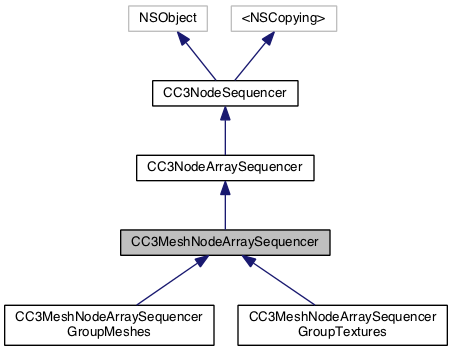#import <CC3NodeSequencer.h>

Instance Methods | |
| (BOOL) | - shouldInsertMeshNode:between:and:withVisitor: |
 Instance Methods inherited from CC3NodeArraySequencer Instance Methods inherited from CC3NodeArraySequencer | |
| (BOOL) | - shouldInsertNode:between:and:withVisitor: |
 Instance Methods inherited from CC3NodeSequencer Instance Methods inherited from CC3NodeSequencer | |
| (BOOL) | - add:withVisitor: |
| (NSString *) | - fullDescription |
| (void) | - identifyMisplacedNodesWithVisitor: |
| (id) | - initWithEvaluator: |
| (void) | - populateFrom: |
| (BOOL) | - remove:withVisitor: |
| (BOOL) | - updateSequenceWithVisitor: |
| (void) | - visitNodesWithNodeVisitor: |
Additional Inherited Members | |
 Class Methods inherited from CC3NodeSequencer Class Methods inherited from CC3NodeSequencer | |
| (id) | + sequencer |
| (id) | + sequencerWithEvaluator: |
 Properties inherited from CC3NodeSequencer Properties inherited from CC3NodeSequencer | |
| BOOL | allowSequenceUpdates |
| CC3NodeEvaluator * | evaluator |
| NSArray * | nodes |
| BOOL | shouldUseOnlyForwardDistance |
An CC3MeshNodeArraySequencer is a type of CC3NodeArraySequencer that only accepts mesh nodes, in addition to whatever other evaluation criteria is set by the evaluator property.
This is a convenience class that allows many mesh-oriented subclasses to be easily created.
For subclass convenience, since this sequencer only accepts mesh nodes, the implementation of the template method shouldInsertNode:between:and:withVisitor: casts the nodes to CC3MeshNode and delegates to the shouldInsertMeshNode:between:and:withVisitor: method.
This base class simply arranges the nodes in the order they are presented. Subclasses will customize the way that the nodes are ordered and grouped in the array.
| - (BOOL) shouldInsertMeshNode: | (CC3MeshNode *) | aNode | |
| between: | (CC3MeshNode *) | leftNode | |
| and: | (CC3MeshNode *) | rightNode | |
| withVisitor: | (CC3NodeSequencerVisitor *) | visitor | |
Attempts to insert the specified node between two specified nodes that already exist in the array, and returns whether it was inserted at that location.
This default implementation always returns NO, resulting in each node always being added to the end of the array.